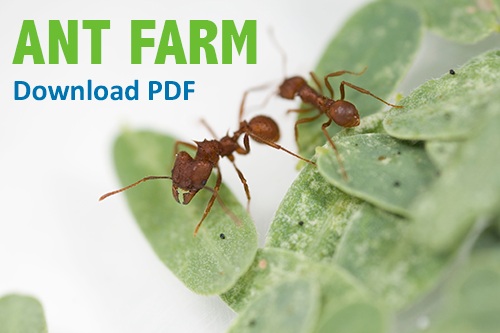show/hide words to know
Mandible: a jaw, or the hard parts of a mouth that work to open and close it. Jaws are used to crush food or to bite.
Humans have many different types of faces, but none of them are as different as the collection of ant faces below.
You can tell a lot about an ant from its face. The shape of the head and mandibles and size of the eyes can reveal the diet and lifestyle of an ant species. Here are some examples of how the structure of an ant’s head corresponds to its function. Once you have learned about all these heads on this page or using the printable ant head summary, try out our ant head match game. Just download the PDF and grab your pencil or pen to see how well you know your ants.
| A typical ant has broad, triangular mandibles with short, pointy teeth. These multi-purpose tools can be used for biting, carrying, digging, and other jobs. |
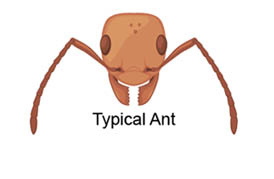 |
|
An army ant solider (Eciton) has massive, hooked mandibles with sharp blades at the tips. They are used to pierce the skin of larger vertebrate predators that threaten the colony. Also note the tiny simple (not compound) eyes – army ants are effectively blind, relying on chemical trails and touch to find their way around in the dark rainforest. |

|
|
This big-headed ant major (Pheidole) has heavy, blunt mandibles powered by a muscular head. It crushes hard seeds that the smaller minor workers harvest but cannot crack. |
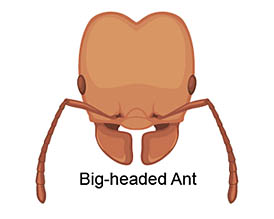
|
|
Bull-dog ants (Myrmecia) have huge, bulging eyes and excellent vision for hunting insect prey. These vicious predators also have long narrow mandibles with big teeth. As their name implies, bull-dog ants can be quite aggressive – workers of some species are known to jump toward human intruders! |
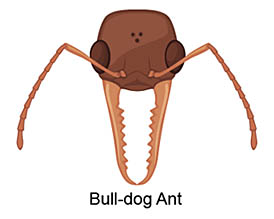
|
|
A leafcutter ant (Atta) has powerful mandibles that slice through leaves like serrated scissors. The leading mandible is anchored into the leaf while the other one is pulled along to make the cut. Leafcutter ants don’t eat the vegetation they collect - they use it to grow fungus, their only source of food. So they are the farmers of the ant world. |
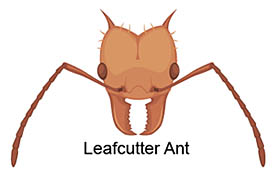
|
|
The marvelous ant (Thaumatomyrmex) has pitch-fork mandibles that are used to grasp its special prey - millipedes covered with long bristles like porcupines. While the ant grips a millipede with its mandibles, it strips off the bristles with pads on its front feet. Once the prey is plucked clean, it is eaten head-first. |
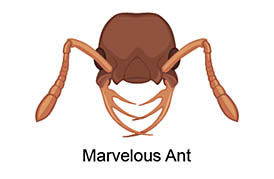
|
|
A trap-jaw ant (Odontomachus) hunts with its mandibles locked wide open and sensitive trigger hairs pointing forward. When the hairs touch a target, energy is released from big muscles in the head, and the mandibles slam shut in a fast and powerful snap. The closing of the mandibles is one of the fastest movements in the animal kingdom – up to 145 miles per hour! That’s 2,300 times faster than the blink of a human eye! Trap-jaw ants use their speedy mandibles to capture springtails and other quick insects. But they can also be used for defense – when a trap-jaw ant points its head down and snaps its mandibles against a hard surface, it launches into the air, out of harm’s way. |

|
|
A turtle ant major (Cephalotes) has an armored, plate-shaped disc covering the front of its head. The disc is perfectly sized to block the nest entrance like a door, preventing enemies from getting inside. |

|
View Citation
Bibliographic details:
- Article: The Many Faces of Ants
- Author(s): Tate Holbrook
- Publisher: Arizona State University School of Life Sciences Ask A Biologist
- Site name: ASU - Ask A Biologist
- Date published: December 17, 2009
- Date accessed: April 17, 2024
- Link: https://askabiologist.asu.edu/many-faces-ants
APA Style
Tate Holbrook. (2009, December 17). The Many Faces of Ants. ASU - Ask A Biologist. Retrieved April 17, 2024 from https://askabiologist.asu.edu/many-faces-ants
Chicago Manual of Style
Tate Holbrook. "The Many Faces of Ants". ASU - Ask A Biologist. 17 December, 2009. https://askabiologist.asu.edu/many-faces-ants
Tate Holbrook. "The Many Faces of Ants". ASU - Ask A Biologist. 17 Dec 2009. ASU - Ask A Biologist, Web. 17 Apr 2024. https://askabiologist.asu.edu/many-faces-ants
MLA 2017 Style
Be Part of
Ask A Biologist
By volunteering, or simply sending us feedback on the site. Scientists, teachers, writers, illustrators, and translators are all important to the program. If you are interested in helping with the website we have a Volunteers page to get the process started.








